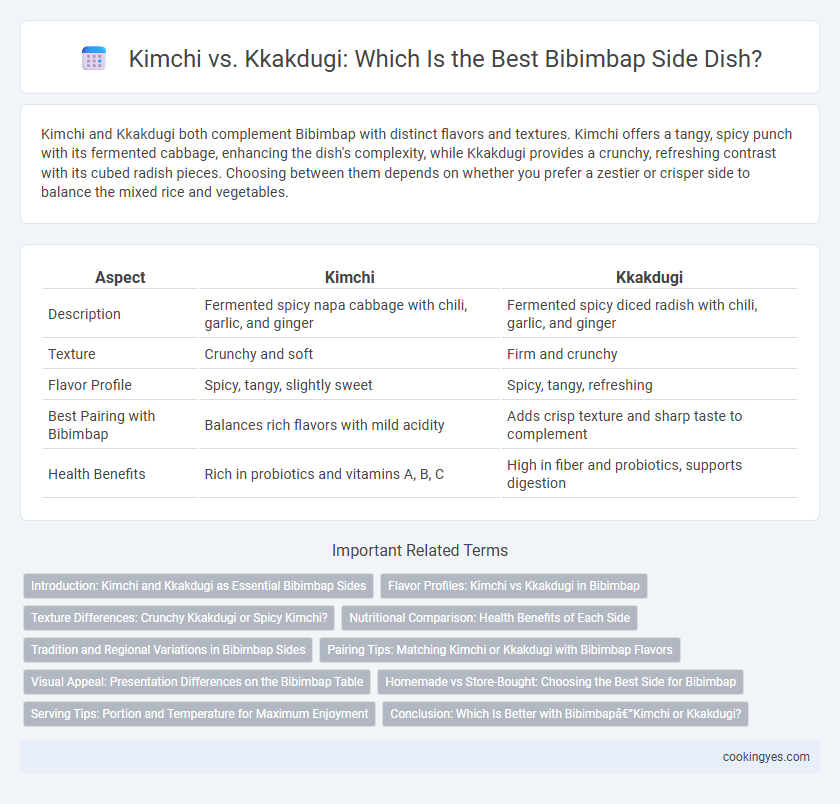Kimchi and Kkakdugi both complement Bibimbap with distinct flavors and textures. Kimchi offers a tangy, spicy punch with its fermented cabbage, enhancing the dish's complexity, while Kkakdugi provides a crunchy, refreshing contrast with its cubed radish pieces. Choosing between them depends on whether you prefer a zestier or crisper side to balance the mixed rice and vegetables.
Table of Comparison
| Aspect | Kimchi | Kkakdugi |
|---|---|---|
| Description | Fermented spicy napa cabbage with chili, garlic, and ginger | Fermented spicy diced radish with chili, garlic, and ginger |
| Texture | Crunchy and soft | Firm and crunchy |
| Flavor Profile | Spicy, tangy, slightly sweet | Spicy, tangy, refreshing |
| Best Pairing with Bibimbap | Balances rich flavors with mild acidity | Adds crisp texture and sharp taste to complement |
| Health Benefits | Rich in probiotics and vitamins A, B, C | High in fiber and probiotics, supports digestion |
Introduction: Kimchi and Kkakdugi as Essential Bibimbap Sides
Kimchi and Kkakdugi are essential side dishes that enhance the flavor of Bibimbap, each offering distinct textures and tastes. Kimchi, a fermented napa cabbage, provides a spicy, tangy crunch that complements the mix of rice and vegetables. Kkakdugi, made from cubed radish, delivers a crisp, mildly sweet flavor that balances Bibimbap's rich and savory elements.
Flavor Profiles: Kimchi vs Kkakdugi in Bibimbap
Kimchi brings a tangy, spicy, and slightly fermented flavor that enhances the savory and umami-rich components of bibimbap, creating a balanced contrast. Kkakdugi, made from cubed radish, offers a crunchier texture with a milder, refreshing bite and subtle sweetness that complements the hearty rice and vegetable mix without overpowering it. Choosing between kimchi and kkakdugi for bibimbap depends on whether a sharper, more pungent flavor or a crisp, clean accent is preferred.
Texture Differences: Crunchy Kkakdugi or Spicy Kimchi?
Kkakdugi offers a crunchy, refreshing contrast to the soft rice and mixed vegetables in Bibimbap, enhancing texture variety with its firm radish cubes. Spicy Kimchi provides a tangy, bold flavor and a softer, slightly chewy texture that blends smoothly into each bite. Choosing between crunchy Kkakdugi and spicy Kimchi depends on whether you prefer texture contrast or harmonious flavor integration in your Bibimbap experience.
Nutritional Comparison: Health Benefits of Each Side
Kimchi and Kkakdugi both offer unique health benefits when paired with Bibimbap, with kimchi rich in probiotics and antioxidants that support gut health and immune function. Kkakdugi, made from radish, provides higher fiber content and vitamin C, aiding digestion and boosting collagen production. Choosing between the two depends on whether you prioritize probiotic intake or vitamin-rich fiber for optimal nutritional enhancement.
Tradition and Regional Variations in Bibimbap Sides
Kimchi and Kkakdugi both serve as popular side dishes for Bibimbap, reflecting rich Korean culinary traditions and regional variations. In the southern regions of Korea, Kimchi, with its fermented napa cabbage, is the preferred accompaniment to Bibimbap, offering a tangy and spicy flavor that complements the dish. Conversely, in the northern and central areas, Kkakdugi, made from diced radish, is commonly paired with Bibimbap, providing a crunchy texture and milder taste that balances the mixed rice bowl's savory components.
Pairing Tips: Matching Kimchi or Kkakdugi with Bibimbap Flavors
Kimchi's tangy, spicy flavor complements bibimbap's rich, savory ingredients, enhancing the overall balance with its fermented zest. Kkakdugi, with its crisp texture and mild sweetness, provides a refreshing contrast that brightens the earthy and nutty notes of bibimbap. For best pairing, choose kimchi to amplify bold, spicy elements and kkakdugi to add a crunchy, cooling counterpoint.
Visual Appeal: Presentation Differences on the Bibimbap Table
Kimchi and Kkakdugi offer distinct visual contrasts as Bibimbap side dishes, with kimchi's deep red, thinly sliced napa cabbage adding vibrant color and texture complexity to the bowl. Kkakdugi's chunky, bright orange cubes provide a bold geometric shape that stands out against the mixed vegetables and rice, enhancing the overall presentation with structured visual appeal. The choice between kimchi's varied hues and fluid form versus kkakdugi's consistent color and form influences the aesthetic balance on a Bibimbap table, highlighting each side dish's unique contribution to the dish's visual composition.
Homemade vs Store-Bought: Choosing the Best Side for Bibimbap
Homemade kimchi offers a complex, fermented flavor profile that enhances bibimbap with authentic tang and crunch, while store-bought versions may lack depth and freshness. Kkakdugi, a diced radish kimchi, provides a crisp texture and mildly spicy kick that complements bibimbap's savory rice and vegetables, with homemade varieties typically showcasing richer, more vibrant flavors. Opting for homemade kimchi or kkakdugi ensures fresher ingredients and customizable seasoning, making it the superior choice for a perfect bibimbap side.
Serving Tips: Portion and Temperature for Maximum Enjoyment
Kimchi and Kkakdugi serve as essential side dishes to Bibimbap, each enhancing flavors with different textures and temperatures. Serving kimchi cold in small, crisp portions around 30 grams complements the warm, mixed rice and vegetables, providing a refreshing contrast. Kkakdugi is best served slightly chilled, around 15-20degC, in similar small amounts to balance the hearty bibimbap without overwhelming its umami depth.
Conclusion: Which Is Better with Bibimbap—Kimchi or Kkakdugi?
Kimchi and Kkakdugi both complement Bibimbap with their unique flavors, but Kkakdugi offers a crunchier texture and milder spice that enhances Bibimbap's mixed rice without overpowering it. Kimchi's tangy and robust flavor adds a strong, fermented kick that can sometimes dominate the delicate balance of ingredients in Bibimbap. For an optimal Bibimbap experience, Kkakdugi is often preferred as a side, balancing freshness and spice to elevate the overall taste harmony.
Kimchi vs Kkakdugi for Bibimbap side Infographic

 cookingyes.com
cookingyes.com